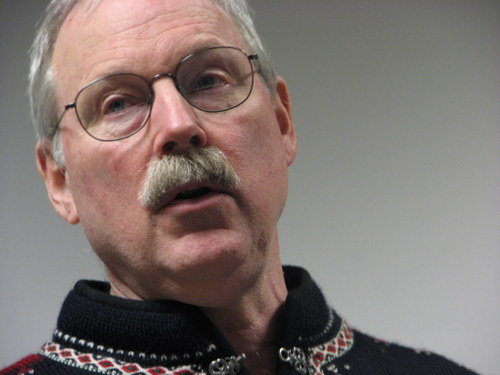
Bert Stedman says that, with tax credits, it’s “mathematically impossible” to reach the 35-percent top tax rate for oil produced on the North Slope. (KCAW photo/Robert Woolsey)
It was a bill that was dead on arrival when it was introduced it in back in February. In an election year, with a high-stakes battle being waged this summer to repeal the governor’s signature oil tax legislation, SB 192 was not going anywhere, and the bill died in committee when the legislature adjourned in April.
But SB 192’s author, Sen. Bert Stedman, still believes there’s a common-sense adjustment to Alaska’s oil tax structure. The Sitka Republican has become a student of the oil industry, and his ideas are influencing the race for governor.
Bert Stedman is standing in front of the Sitka Chamber of Commerce. Gone is the three-piece suit — the uniform of the legislature. He’s wearing a ski sweater and topsiders.
There’s a full house, and the audience has given the senator its full attention for a short lesson in the economics of oil.
Well, I guess the point I want to make is that there’s no such thing as a 35-percent tax rate. To pay 35-percent you’ve got to pump oil. You’ve got to make money to pay taxes. You’ve got to make revenue. What’s the first thing that happens when you pump oil, you get a per-barrel credit. Every barrel you pump in ‘15, that’s $6 bucks a barrel. It’s mathematically impossible to get to 35-percent. Our effective rate for ‘15 is about 22-percent. So, when somebody stands up and says they’ve got a 35-percent base tax, you say, Great, pay it!
It wasn’t too long ago that Gov. Sean Parnell stood in front of this same audience and argued that Alaska was competing against North Dakota, where developments costs were far lower than in the Arctic.
Stedman said the governor’s legislation, SB 21, was not delivering on the promise to increase production. In fact, he said, cash flow had far more to do with oil production than tax structure, and SB 21 was simply pushing money across the table to the North Slope oil producers. Stedman’s SB 192 was intended to address that, by rolling back production credits.
Stedman said that there were people in the room who probably disagreed with him. But there was at least one who didn’t.
“I think he’s right.”
Bill Walker is a former Republican, running as an independent for governor. He says he listened in when Stedman introduced his bill into the Senate Natural Resources Committee.
“I agree with him that SB 21 went too far. There’s a compromise in the middle that everybody stepped over — the middle ground — to go to the extreme. And as a result of that, I think we’re going to pay the price.”
Walker was making a second campaign trip to Sitka and Southeast. His attendance at the Chamber of Commerce on Stedman’s day to speak was coincidental.
Alaska voters will decide whether or not to repeal the governor’s legislation at the August primary. Walker the politician doesn’t think the efforts of Stedman the legislator to suggest a middle path were wasted.
“I think he did it because he wanted it to be on the record, that there’s another option out there.
Stedman also parsed the revenue structure in North Dakota, home to the lower 48’s current oil boom. Subsurface rights in that state — and in Texas — are privately owned. Stedman said no rancher would make the deal that Alaska has with oil companies, and the state is falling behind.
That was the argument. We want to be competitive with North Dakota…
“We’ve always heard about North Dakota, North Dakota, North Dakota. How they’ve got everything right, and we’ve got nothing right. So he did a great job of comparing the tax structure in North Dakota with where we are now. And taking one slice out of his presentation: This year, if Alaska was on the same structure that North Dakota was on, we’d have $1.4-billion more revenue than we do now. We’re $1.4-billion under North Dakota.”
Stedman was appointed to the legislature in 2003 by then-governor Frank Murkowski because of his mind for finance. At the end of a 40-minute talk Stedman can seem embarrassed about his blunt approach to the numbers.
“I’d better be quiet because I don’t want anyone to lose their lunch. I know there are advocates for the other side of the issue in the room, and I’m looking forward to heading to Anchorage to have more detailed discussion (applause).”
“He’s a rarity. Most of those who are out for reelection don’t want to talk about the problem, because someone may say, Aren’t you part of the problem?”
Bert Stedman is not up for re-election this fall, but Gov. Sean Parnell is, and Bill Walker is aiming for that office. He’s hoping that the ideas and economics in a going-nowhere senate bill, will help him get somewhere.































